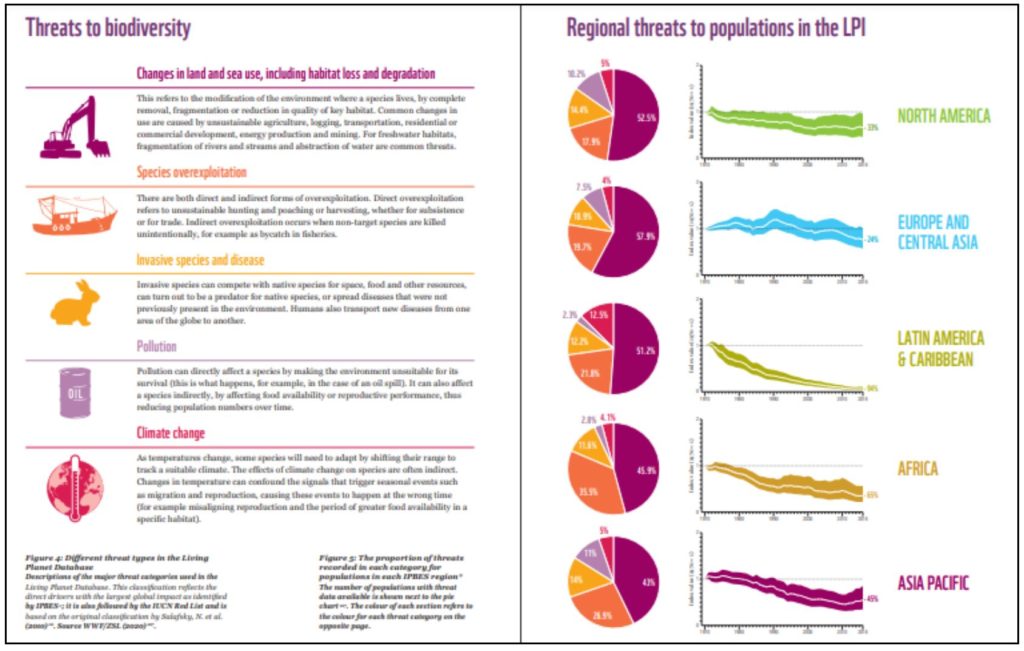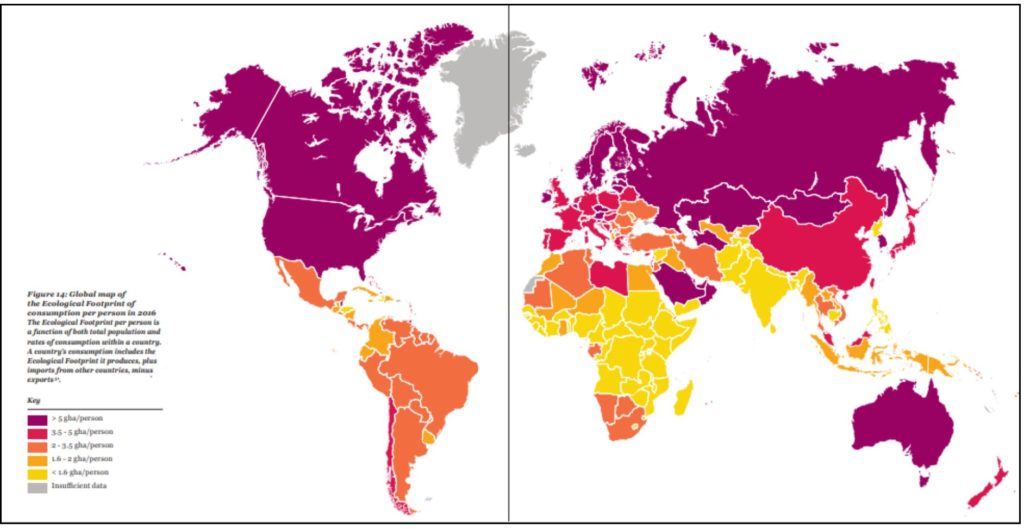The World Wildlife Fund (WWF) recently released the ‘Living Planet Report 2020’. The report paints a grim picture of the loss of biodiversity across the world. It reports an average 68% fall in the monitored vertebrate species populations between 1970 and 2016. The report states that humans are overusing Earth’s biocapacity by at least 56%.
World Wildlife Fund (WWF)’s flagship biennial publication, ‘Living Planet Report’, brings together different research work to provide a comprehensive understanding of the Earth’s health. The latest report for 2020 was released recently. It clearly states how humans’ unsustainable activities are stressing the Earth’s natural systems which essentially support life on the planet.
The Industrial revolution in a way resulted in the modern environmental problems that humans are currently faced with. Human activities have resulted in degradation and damage of forests, wetlands, grasslands, and other key ecosystems, which in turn jeopardize human wellbeing. The Living Planet Index (LPI), provided by the Zoological Society of London (ZSL), is an indicator of the biological diversity. It is calculated on the basis of the trends in population of vertebrate species including mammals, birds, fish, reptiles, and amphibians around the world, considering 1970 to be the base year.
Global vertebrae population down by 2/3rd & freshwater species population down by 84%
As per the 2020 report, data from 20,811 populations of 4,392 species, shows an average 68% decline in monitored populations between 1970 and 2016. That is, the global vertebrate species population witnessed almost a 2/3rd decline in 46 years.
The index calculated for 3,741 populations of freshwater species revealed an average decline by 84%, equivalent to 4% per year since 1970. This was in the case of freshwater animal species including mammals, birds, amphibians, reptiles, and fishes. Most of the decline in this case was evident in freshwater reptiles, fishes, and amphibians, mainly in Latin America and Caribbean regions.
Furthermore, it was also observed that megafauna, or species with a larger body size, were more vulnerable to anthropogenic threat as they require a larger habitat, have lower adaptability, and have only fewer offspring. For instance, in the case of freshwater systems, hippos, river dolphins, otters, and hippos are some of the megafauna species. Human activities such as dam construction obstruct their migratory routes to feeding and breeding grounds.
Status of Flora has been studied in the report for the first time
For the first time, the Living Planet Report also investigates the status of plants, which provide fundamental support for life on earth. The number of terrestrial plants that have been documented to be extinct is double the number of extinct mammals, birds, and amphibians combined. In a sample of thousands of plant species, 22% of the plant species, majority in the tropics, were threatened with extinction. Documenting the extinction of plants is a difficult task, unlike in the case of animals. Similar assessment, to ascertain the risk of extinction of trees are also being carried out.
Insect and butterfly populations are significantly affected
In terms of number of species, insects dominate the animal kingdom. There may be over 5.5 million insect species, with tropics housing the most. In terrestrial ecosystems, insects play a vital role in pollination, pest regulation, processing of nutrients in soil, and are a major source of food for other animals.
In a recent analysis of wild bee and hoverfly carried out in UK, a net loss of 11 species (4 bees and 7 hoverflies) per square kilometre between 1980 and 2013 was recorded. The population of large moths in UK also dropped by 31% between 1969 and 2016. Population of ground beetle species in UK declined by 75% between 1994 and 2008, with population of nearly half of them down by more than 30%. In Germany, insect abundance declined by an alarming 78% between 2008 and 2017 in grassland sites.
Meanwhile, the population of butterflies has declined in Northwest Europe as a result of intensification of agriculture. In the Netherlands, it is estimated that an average of 84% decline occurred between 1890 and 2017 for 71 butterfly species.
While the degradation in environment was rapid in the last few decades, the total GDP has increased four times and extraction of living materials from nature has tripled, and human population has doubled simultaneously.
Five main threats to biodiversity caused by human activities
The 2020 report highlighted the five main threats to biodiversity caused by human activities. They are the following.
- Changes in land and sea use, including habitat loss and degradation: Changes in land and sea use such as modification, fragmentation and pollution resulting from agricultural activities, mining, etc. has been identified to be the largest threat across all regions. 75% of the ice-free land surface on the planet has already been altered, most of the oceans polluted, and more than 85% of the area of wetlands lost.
- Species overexploitation: Intentional (like poaching) or unintentional killing (like bycatch in fishing) of species is the second major cause of biodiversity loss.
- Alien invasive species and disease: Nearly 37% of all recorded alien species were introduced between 1970 and 2014 according to a recent study, impacting human livelihoods and biodiversity.
- Pollution: Pollution affects species directly by making environment unsuitable for survival or indirectly by hindering food availability.
- Climate Change: Increased frequency of extreme weather events and increasing sea levels pose a threat to species.

Per human consumption is among the highest in developed nations
The Earth’s biocapacity is the ability of the planet’s ecosystem to regenerate- that is provide natural resources as well as absorb the waste produced by humans. As per the report, however, humans demand as if they are living off 1.56 Earths. The COVID-19 induced lockdowns across the world reduced human demands by almost 10%. The consumption of natural resources per person across countries (ecological footprint) shows that the consumption is high in the developed countries such as USA, Australia, and Russia. India’s per person consumption is among the lowest, less than 1.6 global hectares per person. However, multiple factors such as accessibility, affordability, and availability, come at play when it comes to resource consumption.

Food wastage should be limited
As per the report, wastage in food is not only a major contributor to climate change, but also is a wastage in terms of land, water, energy, labour, capital, and other resources that go into its production. Food lost in supply chains or wasted by consumers account for 6% of global greenhouse gas emissions (which is three times the emissions due to aviation) and nearly a quarter of all emissions from food production. Weaknesses in global food system were exposed by the pandemic.
Thus, introduction of national food wastage targets and policies will prove to be an effective step forward. Overconsumption, specifically that of meat, should also be avoided. Foods that are rich in vitamins and minerals that provide immunity should be made available for all, irrespective of wealth. The current economic policies of governments (e.g.: direct or indirect subsidies to use fossil fuels) that incentivize environment damage cannot be eliminated because of political complexities. What can be done is to incentivize individual behaviours, as per the report.
India’s ecologically intact land is among the most damaged
Since the year 2000, ecologically intact land, free from human pressure in the size of Mexico has been lost, mainly in tropical and sub-tropical grasslands, savannah, and shrubland ecosystems and the Southeast Asian rainforests. Only 25% of land on earth distributed in Russia, Canada, Brazil, and Australia can be considered ‘wilderness’ without human presence. India is among the countries that have highly modified the ecologically pristine land. Similarly, hardly 13% of the Oceans can be considered ‘wilderness’. Warming up of oceans, plastic pollution, overfishing, coral bleaching, and coastal ‘development’ have altered the marine ecosystem. Ocean heatwaves have already destroyed half the corals on Australia’s Great Barrier Reef. Scientists have projected that a 2°C global temperature rise will result in the almost complete eradication of coral reefs across the planet.
Future pandemics may be avoided by safeguarding environment
In 2019 and 2020, there have been unprecedented natural events such as locust attacks, bushfires, droughts and extreme heatwaves, heavy cyclones, and the coronavirus pandemic that have resulted in irreparable damage and heavy losses, all because of climate change and environmental degradation. Even though the origin of COVID-19 has not yet been established, 60% of emerging infectious diseases are zoonotic- emerging from animals. The Nipah outbreak in Malaysia, SARS in China, Ebola in West Africa are some of the diseases caused by anthropogenic alterations to the ecological systems which naturally regulate pathogenic risk. This calls for environmental interventions to safeguard human health by protecting environmental health. The effects can be catastrophic if these are not taken care of.
Transformational change is an urgent requirement
Many countries were already lagging in achieving global targets and goals such as SDGs that governments had signed up for. This gets further exacerbated if biodiversity loss, which is intertwined with other SDGs such as poverty alleviation and health, is not addressed. A transformational change is what is needed now with changes in production and consumption patterns of food and energy, increased conservation efforts, and a global collective effort. Citizens, governments, and business leaders should all come together and create a movement before it is too late to ‘bend the curve’.


